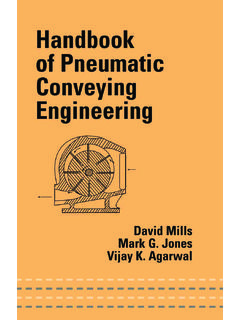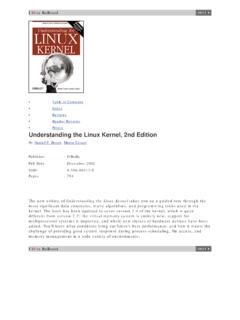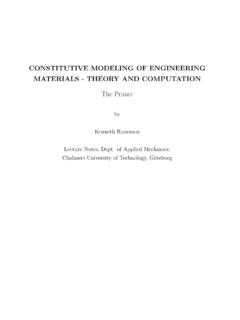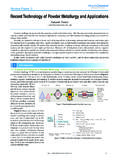Transcription of PH TOC PDF - nguyen.hong.hai.free.fr
1 Contents Contributors .. v Preface .. ix I. Nomenclature Rules Units Nomenclature .. I/1. A. Introduction .. I/1. B. IUPAC Recommendations .. I/1. 1. Source-based Nomenclature .. I/2. Homopolymers .. I/2. Copolymers .. I/2. Nonlinear Macromolecules and Macromolecular Assemblies .. I/3. 2. Structure-based Nomenclature .. I/3. Regular Single-strand Organic Polymers .. I/3. Regular Double-strand Organic Polymers .. I/6. Regular Single-strand Inorganic and Coordination Polymers .. I/6. Regular Quasi-single-strand Coordination Polymers .. I/7. Irregular Single-strand Organic Polymers .. I/7. C. Use of Common and Semisystematic Names .. I/8. D. Chemical Abstracts (CA) Index Names .. I/8. E. Polymer Class Names .. I/11. F. References.
2 I/12. Units .. I/13. A. Introduction .. I/13. B. International Units .. I/13. C. SI-prefixes .. I/14. D. Conversion Factors .. I/14. E. Conversion Table for SI vs. English-american Units .. I/17. II. Polymerization and Depolymerization Decomposition Rates of Organic Free Radical Initiators .. II/1. A. Introduction .. II/1. B. Tables of Decomposition Rates of Organic Free Radical Initiators .. II/2. Table 1. Azonitriles .. II/2. Table 2. Miscellaneous Azo-derivatives .. II/9. This page has been reformatted by Knovel to provide easier navigation. xi xii Contents Table 3. Alkyl Peroxides .. II/23. Table 4. Acyl Peroxides .. II/29. Table 5. Hydroperoxides and Ketone Peroxides .. II/43. Table 6. Peresters and Peroxycarbonates.
3 II/48. Table 7. Miscellaneous Initiators .. II/67. C. Notes .. II/69. D. References .. II/70. Propagation and Termination Constants in Free Radical Polymerization .. II/77. A. Introduction .. II/77. B. Tables of Propagation and Termination Constants .. II/79. Table 1. Dienes .. II/79. Table 2. Olefins .. II/79. Table 3. Acrylic Derivatives .. II/80. Table 4. Methacrylic Derivatives .. II/82. Table 5. Itaconic Derivatives .. II/85. Table 6. Fumaric Derivatives .. II/87. Table 7. Vinyl Halides .. II/87. Table 8. Vinyl Esters .. II/87. Table 9. Vinyl Ethers .. II/88. Table 10. Styrene Derivatives .. II/88. Table 11. Vinyl Heteroaromatics .. II/90. Table 12. Aldehydes .. II/90. Table 13. Others .. II/90. C. References.
4 II/91. Transfer Constants to Monomers, Polymers, Catalysts and Initiators, Solvents and Additives, and Sulfur Compounds in Free Radical Polymerization .. II/97. A. Introduction .. II/97. B. Tables of Transfer Constants .. II/98. Table 1. Transfer Constants to Monomers .. II/98. Table 2. Transfer Constants to Polymers .. II/103. Table 3. Transfer Constants to Catalysts and Initiators .. II/106. Table 4. Transfer Constants to Solvents and Additives .. II/110. Table 5. Transfer Constants to Sulfur Compounds .. II/150. C. Remarks .. II/157. D. References .. II/159. Photopolymerization Reactions .. II/169. A. Introduction .. II/169. B. Tables .. II/170. Table 1. Rate Constants of Cleavage, Electron Transfer and Monomer Quenching in Radical Photoinitiators.
5 II/170. Annex to Table 1. Photoinitiator Compound Chemistries .. II/173. This page has been reformatted by Knovel to provide easier navigation. Contents xiii Table 2. Bimolecular Rate Constants for the Reaction of Phosphonyl Radicals with Various Monomers in Cyclohexane at Room Temperature .. II/176. Table 3. Bimolecular Rate Constants for the Reaction of Various Radicals with Various Olefinic Monomers at Room Temperature .. II/176. Table 4. Bimolecular Rate Constants for the Reaction of Ph2P = O and Ph2P = S with Various Monomers .. II/176. Table 5. Electron Transfer Reaction of Radicals with Diphenyliodonium Salts .. II/176. Table 6. Electron Transfer Rate Constants (ke) between Photosensitizers and Cationic Photoinitiators and Quenching Rate Constants (kq) for Cyclohexene Oxide in Methanol (M) and Acetonitrile (AN).
6 II/177. Table 7. Excitation Transfer Rate Constants (kT) for Thioxanthones and Photoinitiators .. II/178. Annex to Table 7. Compound Chemistries .. II/178. Table 8. Triplet State Lifetimes ( T) of the Sensitizer (TXI) in Different Media, and Rate Constant (kT) of the Interaction between TXI and TPMK .. II/179. Table 9. Some Values of the Triplet State Energy Levels of Photoinitiators and Monomers .. II/179. Table 10. Values of 0T, T, and kba in Solution .. II/179. Table 11. Rate Constant of Interaction of Ketones and Light Stabilizers in Solution .. II/179. Annex to Table 11 .. II/179. C. References .. II/180. Free Radical Copolymerization Reactivity Ratios .. II/181. A. Introduction .. II/181. B. Tables .. II/182.
7 Table 1. Copolymer Reactivity Ratios .. II/182. Acenaphthalene to Fumarate, bis(3-chloro-2-butyl) .. II/182. Fumarate, di-(2-chloroethyl) to N-N-divinylaniline .. II/212. N-vinylimidazole to Styrene, p-2-(2-hydroxypropyl)- .. II/241. Styrene, p-4-methoxyphenyl ketone to Vinylbenzoate, p-, sodium .. II/268. Vinylbenzoic acid, p- to Xanthate, S-methacryloyl O-ethyl .. II/285. Table 2. Listing of Quick Basic (Microsoft) Program for Calculating Reactivity Ratios .. II/288. C. References .. II/290. Q and e Values for Free Radical Copolymerizations of Vinyl Monomers and Telogens .. II/309. A. Introduction .. II/309. B. Q and e Values for Free Radical Copolymerizations .. II/310. Table 1. Monomers .. II/310. Table 2. Telogens.
8 II/314. Table 3. Monomers Arranged by Q Values .. II/314. Table 4. Monomers Arranged by e Values .. II/317. C. References .. II/319. Patterns of Reactivity (U,V) Parameters for the Prediction of Monomer Reactivity Ratios and Transfer Constants in Radical Polymerization .. II/321. A. Introduction .. II/321. This page has been reformatted by Knovel to provide easier navigation. xiv Contents B. Example .. II/322. C. Transfer Constants .. II/322. D. Tables of Parameters .. II/323. Table 1. Monomers .. II/323. Table 2. Transfer Agent .. II/326. E. References .. II/327. Copolymerization Parameters of Metallocene-catalyzed Copolymerizations .. II/329. A. Introduction .. II/329. B. A Brief Theoretical Outline of Copolymerization Reactions.
9 II/329. 1. First-order Markov Model .. II/330. 2. Second-order Markov Model .. II/330. C. Calculation of the Copolymerization Parameters .. II/331. 1. First-order Markov Model .. II/331. Copolymerization Parameters Deduced from the Mayo-lewis Equation .. II/331. Determination of Copolymerization Parameters from the Sequence Distribution (Triad Distribution) .. II/331. 2. Second-order Markov Model .. II/332. 3. Example .. II/332. D. Table of Copolymerization Parameters .. II/333. E. List of Catalysts/Cocatalysts Used .. II/336. F. References .. II/336. Rates of Polymerization and Depolymerization, Average Molecular Weights, and Molecular Weight Distribution of Polymers .. II/339. A. Introduction .. II/339. B. Reference Tables for the Calculation of Rates of Polymerization, Average Molecular Weights, and Molecular Weight Distributions of Polymers for Various Types of Polymerization.
10 II/340. Table 1. Addition Polymerization with Termination .. II/341. Table 2. Addition Polymerization - "Living" Polymers with Partial Deactivation .. II/344. Table 3. Linear Condensation Polymerization without Ring Formation .. II/346. Table 4. Equilibrium Polymerization .. II/347. Table 5. Nonlinear Polymerization Systems .. II/348. Table 6. Degradation of Polymers - May Be Accompanied by Crosslinking .. II/350. Table 7. Influence of Reactor Conditions and Design on the Molecular Weight Distribution .. II/352. C. Some Distribution Functions and Their Properties .. II/352. 1. Normal Distribution Function (Gaussian Distribution) .. II/353. 2. Logarithmic Normal Distribution Function .. II/353. 3. Generalized Exponential Distribution.












